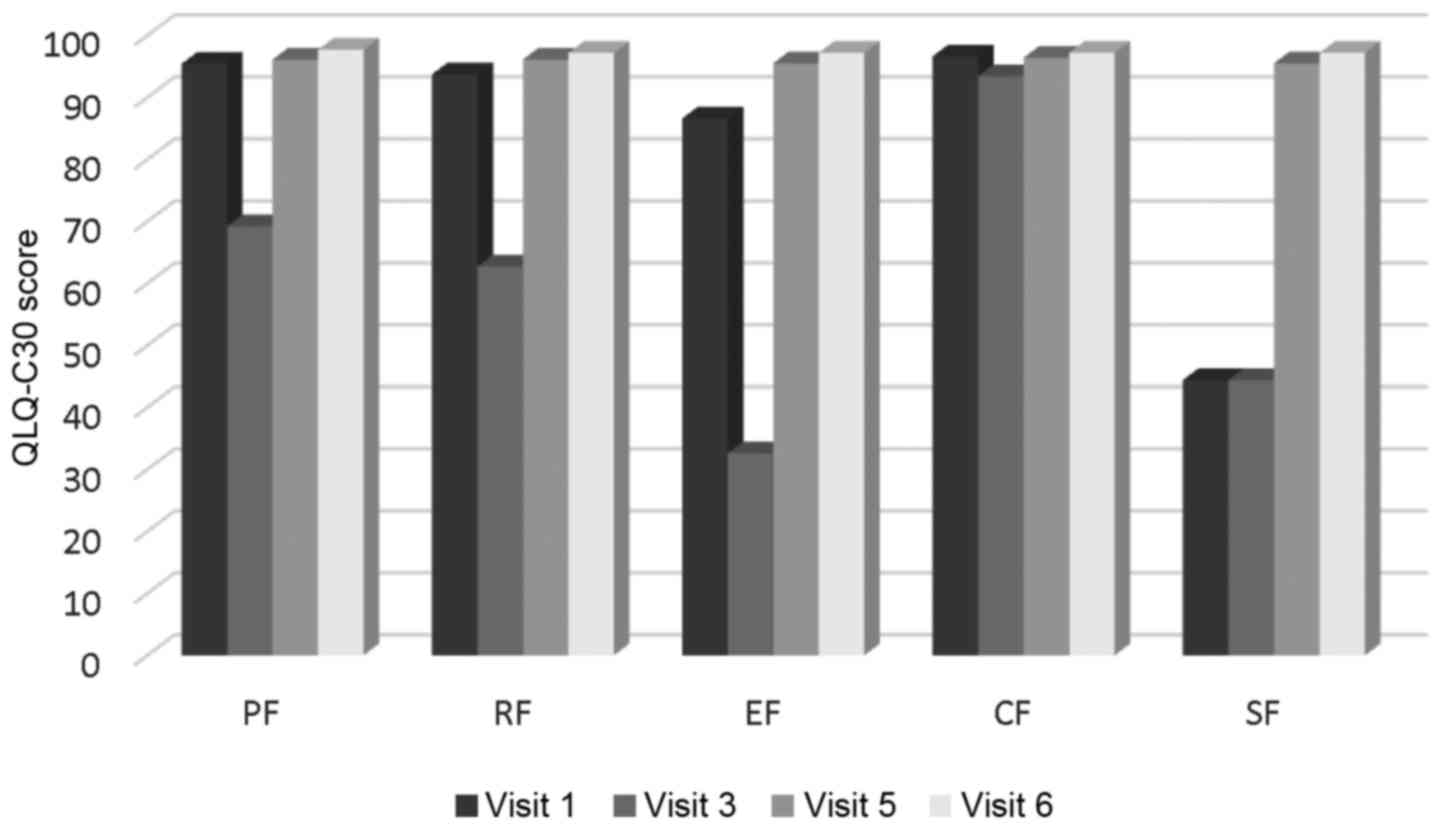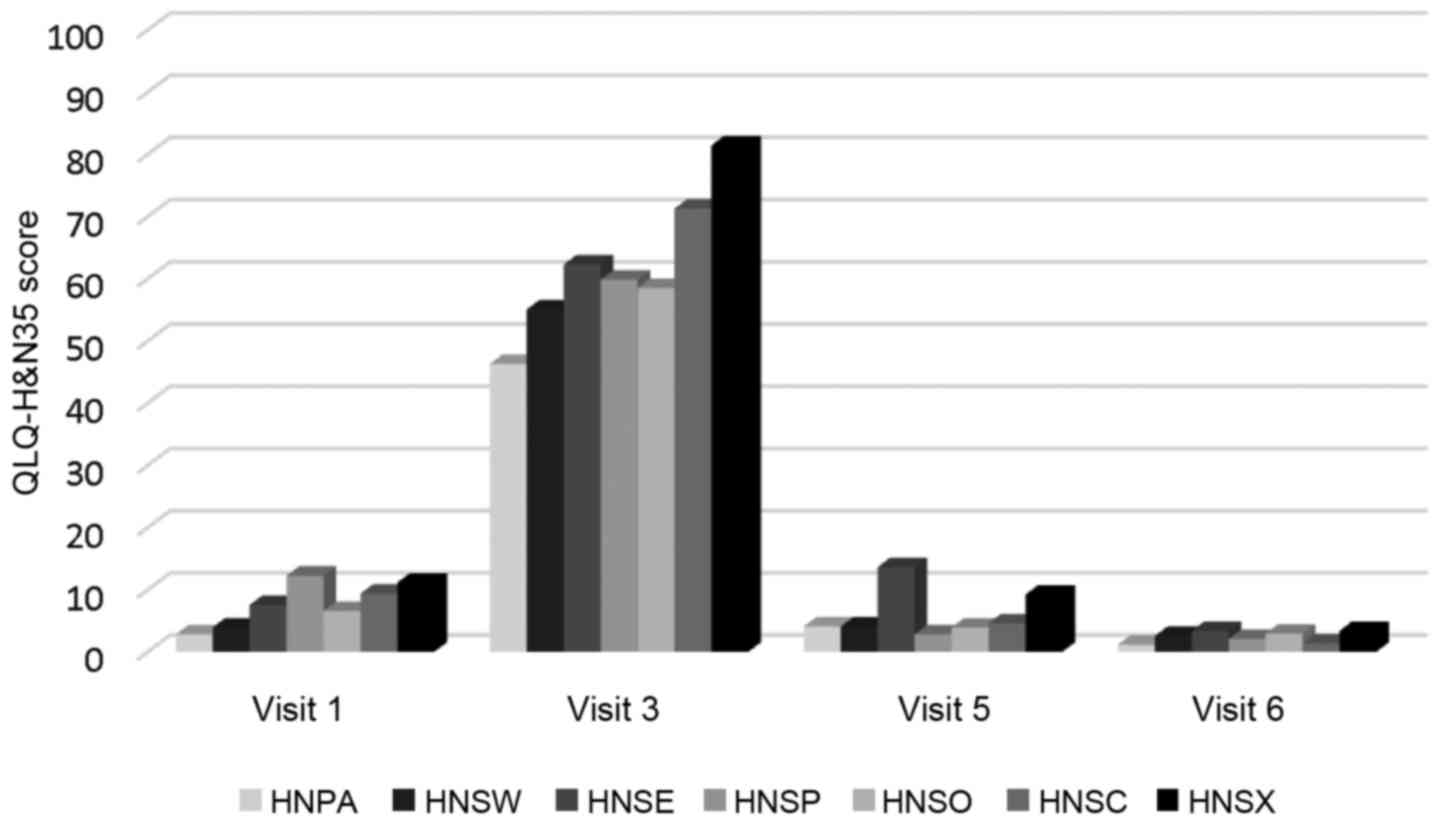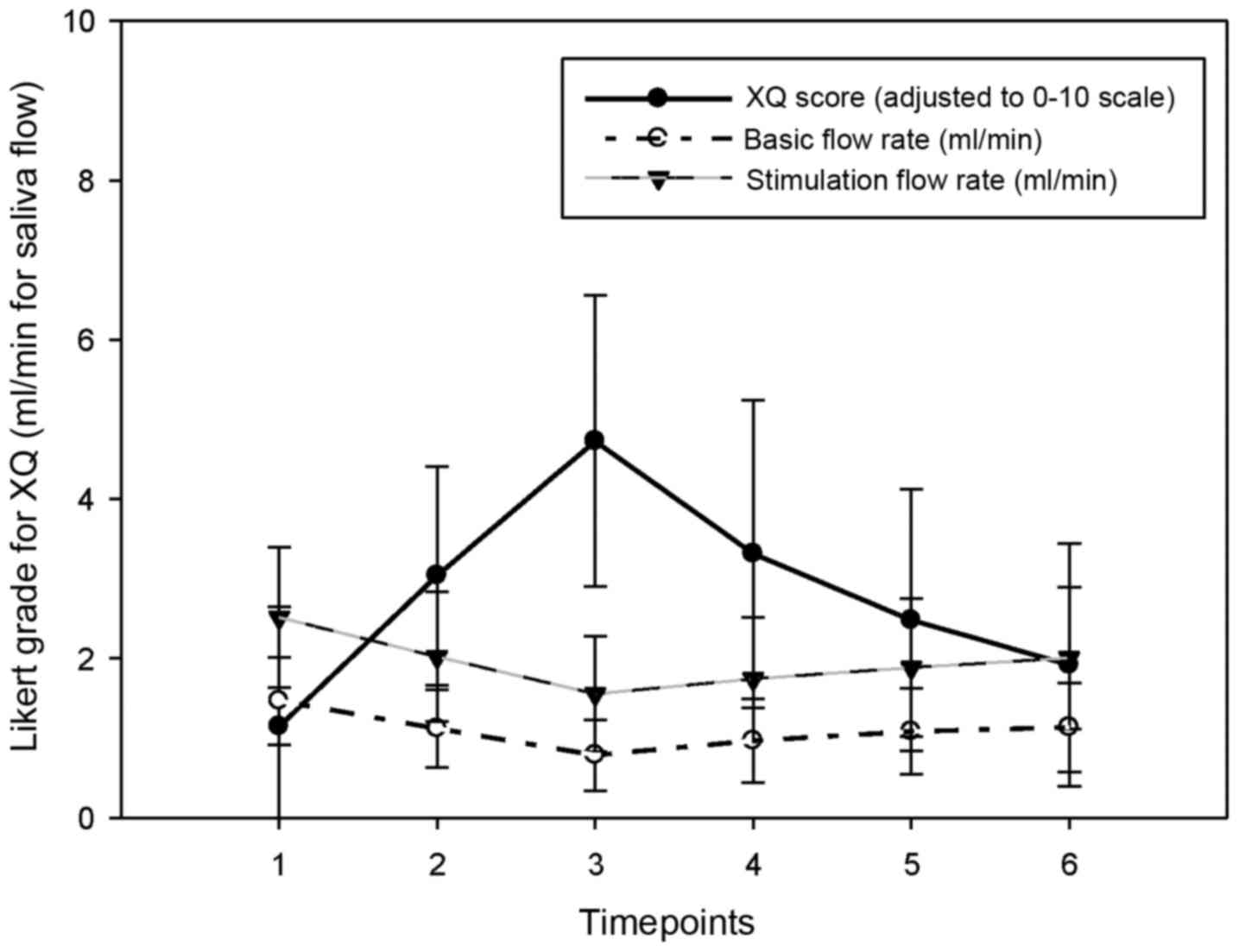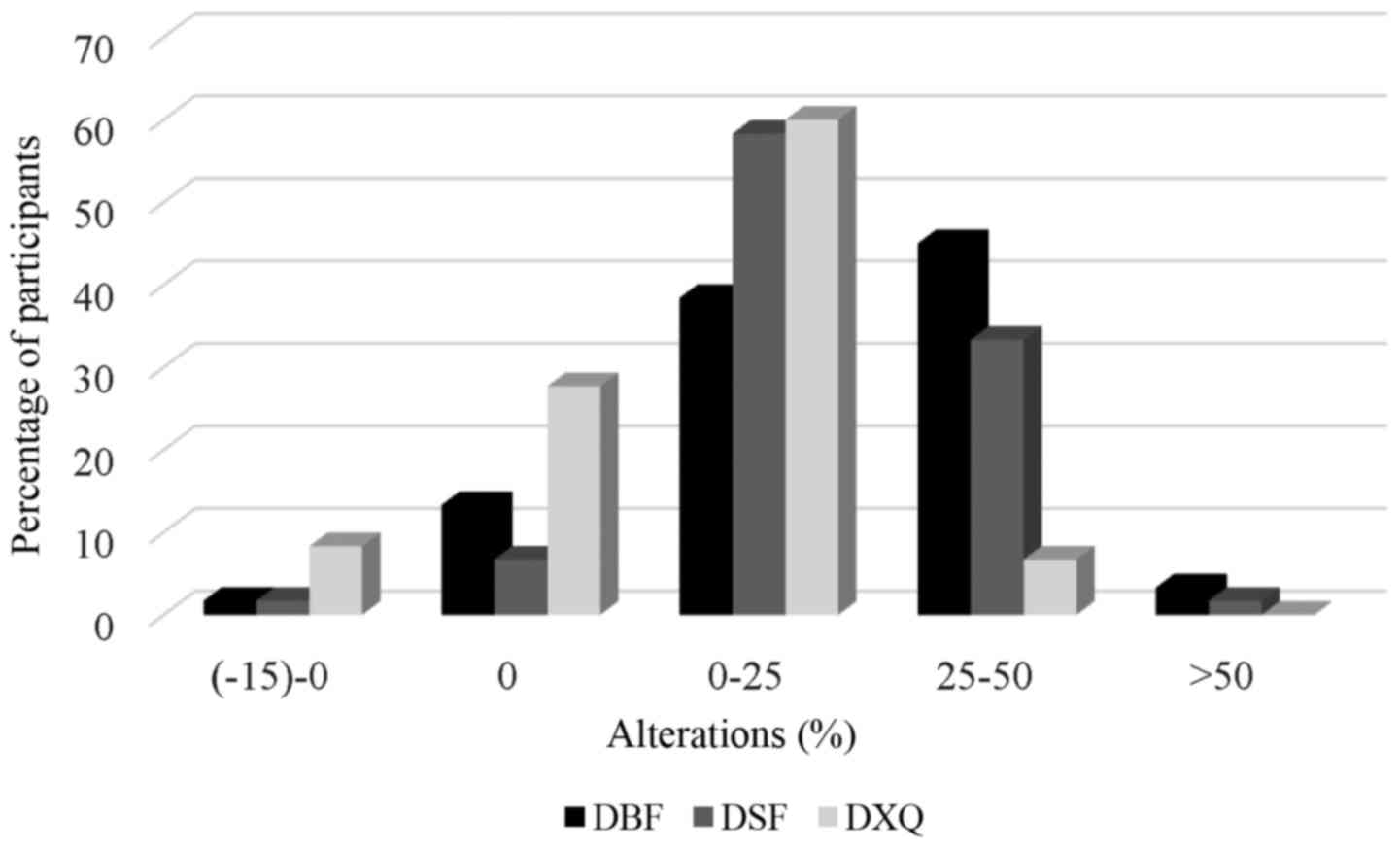|
1
|
Guobis Z, Baseviciene N, Paipaliene P,
Sabalys G and Kubilius R: Xerostomia: Clinic, etiology, diagnosis
and treatment. Medicina (Kaunas). 42:171–179. 2006.(In Lithuanian).
PubMed/NCBI
|
|
2
|
Pow EH, Kwong DL, McMillan AS, Wong MC,
Sham JS, Leung LH and Leung WK: Xerostomia and quality of life
after intensity-modulated radiotherapy vs. conventional
radiotherapy for early-stage nasopharyngeal carcinoma: Initial
report on a randomized controlled clinical trial. Int J Radiat
Oncol Biol Phys. 66:981–991. 2006. View Article : Google Scholar : PubMed/NCBI
|
|
3
|
Liu XK, Zeng ZY, Hong MH, Zhang AL, Cui NJ
and Chen FJ: [Clinical analysis of xerostomia in patients with
nasopharyngeal carcinoma after radiation therapy]. Ai Zheng.
23:593–596. 2004.PubMed/NCBI
|
|
4
|
Ledeboer QC, Velden LA, Boer MF, Feenstra
L and Pruyn JF: Physical and psychosocial correlates of head and
neck cancer: An update of the literature and challenges for the
future (1996–2003). Clin Otolaryngol. 30:303–319. 2005. View Article : Google Scholar : PubMed/NCBI
|
|
5
|
Heutte N, Plisson L, Lange M, Prevost V
and Babin E: Quality of life tools in head and neck oncology. Eur
Ann Otorhinolaryngol Head Neck Dis. 131:33–47. 2014. View Article : Google Scholar : PubMed/NCBI
|
|
6
|
Meirovitz A, Murdoch-Kinch CA, Schipper M,
Pan C and Eisbruch A: Grading xerostomia by physicians or by
patients after intensity-modulated radiotherapy of head-and-neck
cancer. Int J Radiat Oncol Biol Phys. 66:445–453. 2006. View Article : Google Scholar : PubMed/NCBI
|
|
7
|
Pacholke HD, Amdur RJ, Morris CG, Li JG,
Dempsey JF, Hinerman RW and Mendenhall WM: Late xerostomia after
intensity-modulated radiation therapy versus conventional
radiotherapy. Am J Clin Oncol. 28:351–358. 2005. View Article : Google Scholar : PubMed/NCBI
|
|
8
|
Jabbari S, Kim HM, Feng M, Lin A, Tsien C,
Elshaikh M, Terrel JE, Murdoch-Kinch C and Eisbruch A: Matched
case-control study of quality of life and xerostomia after
intensity-modulated radiotherapy or standard radiotherapy for
head-and-neck cancer: Initial report. Int J Radiat Oncol Biol Phys.
63:725–731. 2005. View Article : Google Scholar : PubMed/NCBI
|
|
9
|
Bjordal K, Hammerlid E, Ahlner-Elmqvist M,
de Graeff A, Boysen M, Evensen JF, Biörklund A, de Leeuw JR, Fayers
PM, Jannert M, et al: Quality of life in head and neck cancer
patients: Validation of the European Organization for Research and
Treatment of Cancer Quality of Life Questionnaire-H&N35. J Clin
Oncol. 17:1008–1019. 1999. View Article : Google Scholar : PubMed/NCBI
|
|
10
|
Aaronson NK, Ahmedzai S, Bergman B,
Bullinger M, Cull A, Duez NJ, Filiberti A, Flechtner H, Fleishman
SB, de Haes JC, et al: The European Organization for Research and
Treatment of Cancer QLQ-C30: A quality-of-life instrument for use
in international clinical trials in oncology. J Natl Cancer Inst.
85:365–376. 1993. View Article : Google Scholar : PubMed/NCBI
|
|
11
|
Memtsa PT, Tolia M, Tzitzikas I, et al:
Validity and reliability of the Greek version of the xerostomia
questionnaire in head and neck cancer patients. Supportive care in
cancer: official journal of the Multinational Association of
Supportive Care in Cancer. 2016.(In press). PubMed/NCBI
|
|
12
|
Kakoei S, Haghdoost AA, Rad M,
Mohammadalizadeh S, Pourdamghan N, Nakhaei M and Bahador M:
Xerostomia after radiotherapy and its effect on quality of life in
head and neck cancer patients. Arch Iran Med. 15:214–218.
2012.PubMed/NCBI
|
|
13
|
Shahdad SA, Taylor C, Barclay SC, Steen IN
and Preshaw PM: A double-blind, crossover study of Biotène
Oralbalance and BioXtra systems as salivary substitutes in patients
with post-radiotherapy xerostomia. Eur J Cancer Care (Engl).
14:319–326. 2005. View Article : Google Scholar : PubMed/NCBI
|
|
14
|
Pinna R, Campus G, Cumbo E, Mura I and
Milia E: Xerostomia induced by radiotherapy: An overview of the
physiopathology, clinical evidence, and management of the oral
damage. Ther Clin Risk Manag. 11:171–188. 2015. View Article : Google Scholar : PubMed/NCBI
|
|
15
|
Roesink JM, Schipper M, Busschers W,
Raaijmakers CP and Terhaard CH: A comparison of mean parotid gland
dose with measures of parotid gland function after radiotherapy for
head-and-neck cancer: Implications for future trials. Int J Radiat
Oncol Biol Phys. 63:1006–1009. 2005. View Article : Google Scholar : PubMed/NCBI
|
|
16
|
Braam PM, Roesink JM, Moerland MA,
Raaijmakers CP, Schipper M and Terhaard CH: Long-term parotid gland
function after radiotherapy. Int J Radiat Oncol Biol Phys.
62:659–664. 2005. View Article : Google Scholar : PubMed/NCBI
|
|
17
|
Scharloo M, de Baatenburg Jong RJ,
Langeveld TP, van Velzen-Verkaik E, den Doorn-Op Akker MM and
Kaptein AA: Illness cognitions in head and neck squamous cell
carcinoma: Predicting quality of life outcome. Support Care Cancer.
18:1137–1145. 2010. View Article : Google Scholar : PubMed/NCBI
|
|
18
|
Filho Melo MR, Rocha BA, Pires MB, Fonseca
ES, Freitas EM, Junior Martelli H and Santos FB: Quality of life of
patients with head and neck cancer. Braz J Otorhinolaryngol.
79:82–88. 2013. View Article : Google Scholar : PubMed/NCBI
|













